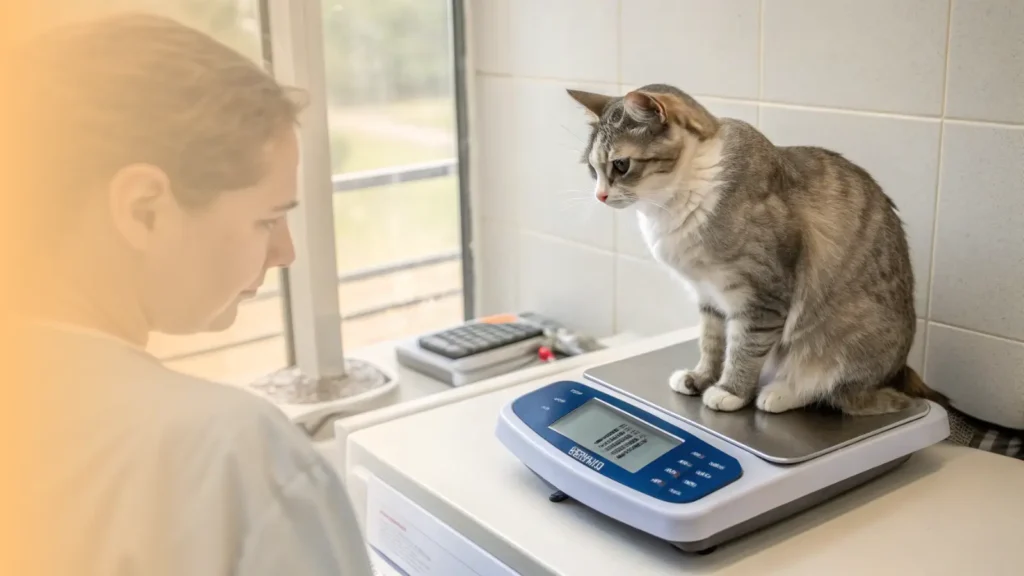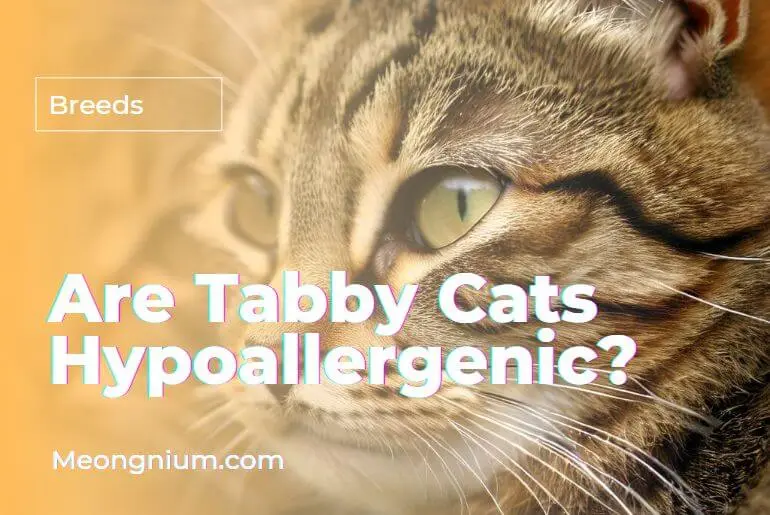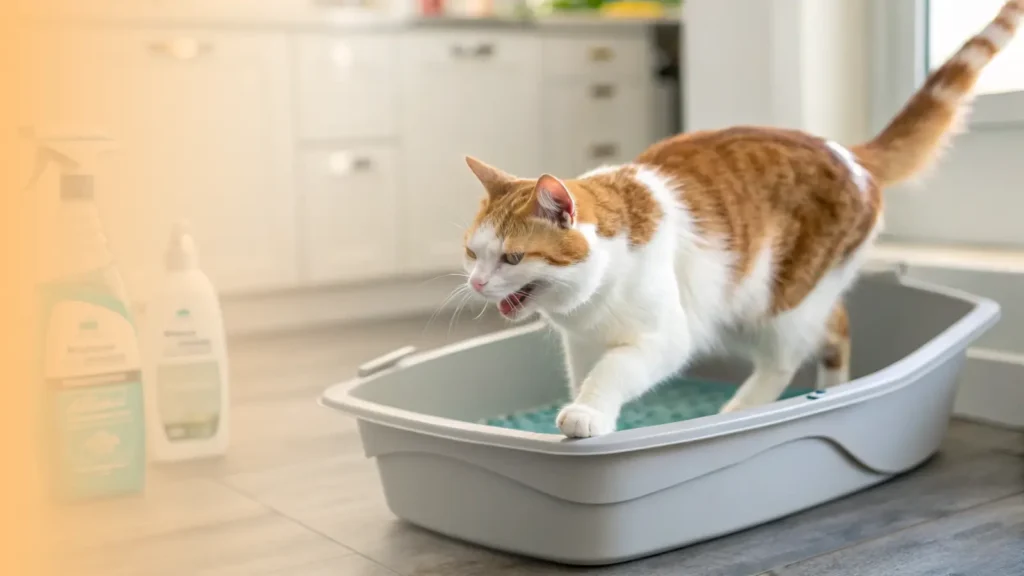It’s a feeling that every cat owner dreads, that moment you pick up your cat and they feel just a little too light. Unexplained weight loss is more than just a number on a scale, it’s a clear signal from your cat that something is wrong. After years of caring for cats, including seniors with complex health issues, I’ve learned that understanding the potential causes is the first step toward getting them the help they need.
The Ultimate Guide to Unexplained Weight Loss in Cats
Key Takeaways
- Any unintentional weight loss of more than 5% of your cat’s body weight is significant and requires a veterinary visit.
- Your cat’s appetite is the most important clue you can give your vet. Weight loss with a ravenous appetite points to different issues than weight loss with no appetite.
- In middle-aged and senior cats, the most common medical causes are Chronic Kidney Disease (CKD), Hyperthyroidism, and Diabetes.
- You can be your vet’s best partner by closely tracking your cat’s food and water intake, litter box habits, and any changes in behavior.
What Is Considered Significant Weight Loss in Cats?
Significant weight loss in a cat is clinically defined as an unintentional loss of more than 5% of their stable body weight. For a ten-pound cat, this means losing just half a pound is enough to be a concern. I’ve found in my own experience that a simple baby scale is a great tool for tracking my senior cat’s weight weekly, as this gradual wasting can be insidious and hard to notice day to day. Whether the weight drops off rapidly over a few days or slowly over several months, any unexplained decrease signals an imbalance that warrants a professional evaluation.
The Three Main Reasons a Cat Loses Weight
At its core, weight loss is a simple equation where calories burned are greater than calories consumed. This negative energy balance is almost always driven by one of three underlying functional problems. Understanding which one is at play is the first step in the diagnostic journey.
1. The Cat Isn’t Eating Enough Calories
This is the most straightforward cause, where a cat is simply consuming fewer calories than its body requires to function. This state of insufficient caloric intake can happen for many reasons. Your cat might have a reduced or absent appetite, known as hyporexia or anorexia, due to nausea from an underlying illness. Alternatively, a condition like severe dental disease can make the act of chewing so painful that the cat avoids eating even when it’s hungry.
2. The Cat Can’t Absorb Nutrients From Its Food
In this scenario, the cat is eating normally or even more than usual, but the food isn’t providing any benefit. This happens when the gastrointestinal system is unable to properly break down food into usable components, a problem called maldigestion, or it can’t transport those nutrients into the bloodstream, a problem called malabsorption. The calories are ingested but are ultimately lost in the feces, leaving the cat’s body effectively starving.
3. The Cat’s Body Is Burning Too Much Energy
This mechanism involves a pathologically elevated metabolic rate, often described as a “metabolic fire.” The body’s energy expenditure is so accelerated that even a normal or increased food intake can’t keep up with the demand. This hypermetabolic state forces the body to burn through its own fat and muscle stores for fuel, leading to rapid wasting even while the cat seems to be eating well.
What Your Cat’s Appetite Reveals About the Cause
The single most powerful piece of information you can give your veterinarian is an accurate report of your cat’s appetite. From my own discussions with vets, I know this one detail immediately helps them divide the long list of potential causes into two, much more manageable categories. It creates a critical fork in the diagnostic road.
1. Reasons for Weight Loss with a Decreased Appetite
This is the more common clinical presentation, where a cat is losing weight because it’s not eating enough to meet its needs. This points toward a wide array of conditions that cause nausea, pain, systemic inflammation, or general malaise that makes eating undesirable or difficult. Common culprits in this category include Chronic Kidney Disease, various cancers, dental disease, and even psychological stress.
2. Reasons for Weight Loss with an Increased Appetite
This paradoxical combination of a ravenous appetite and ongoing weight loss is a highly significant and more specific clinical sign. When a cat is eating you out of house and home yet continues to get thinner, it strongly suggests a disease is either preventing nutrient use or dramatically speeding up metabolism. This immediately focuses the investigation on a shortlist of major disorders, primarily Hyperthyroidism, Diabetes Mellitus, and Exocrine Pancreatic Insufficiency (EPI).
Major Medical Conditions That Cause Weight Loss
While stress or dietary issues can cause weight loss, a persistent, unexplained drop in weight is most often linked to an underlying medical condition. These are some of the most common diseases vets investigate first, especially in adult and senior cats.
Chronic Kidney Disease (CKD)
CKD is a leading cause of weight loss in older cats. As kidney function declines, toxic waste products build up in the blood, causing chronic nausea and a significant loss of appetite.
Hyperthyroidism (Overactive Thyroid)
This is the most common endocrine disease in cats over 10, caused by a benign tumor on the thyroid gland. It floods the body with thyroid hormone, sending the metabolism into overdrive and causing the cat to burn through calories and muscle mass at an alarming rate.
Diabetes Mellitus
In diabetic cats, a lack of effective insulin means that glucose, the body’s main fuel, can’t get into the cells. The cells are essentially starving in a sea of plenty, forcing the body to break down fat and muscle for energy, which causes weight loss despite a often ravenous appetite.
Gastrointestinal (GI) Diseases
Conditions like Inflammatory Bowel Disease (IBD) cause chronic inflammation that damages the intestinal lining, preventing the absorption of nutrients. This leads to weight loss even when the cat is eating well.
Cancer
Cancer can cause weight loss in several ways. A tumor might physically interfere with eating or digestion, but more often, it triggers a devastating wasting syndrome called cancer cachexia, where the tumor competes for nutrients and releases inflammatory substances that cause muscle breakdown.
Dental Disease and Oral Pain
Severe oral pain from conditions like tooth root abscesses, resorptive lesions, or advanced periodontal disease can make chewing so agonizing that a cat will simply stop eating. While it often contributes to poor appetite, I’ve seen that it’s rarely the sole cause of profound weight loss.
Can Diet and Environment Cause Weight Loss?
Before jumping to a conclusion about a serious illness, it’s important to rule out more straightforward environmental or dietary causes. I always check these simple factors first when a cat seems to be dropping weight. Sometimes the fix is much easier than you think.
1. How Your Cat’s Food Can Be a Factor
The simplest explanation for weight loss is often a miscalculation in calories. An owner may have unintentionally switched to a lower-calorie “light” formula without adjusting the feeding amount. Cats can also be notoriously picky, and a new food that they dislike in taste or texture can lead to a refusal to eat and a subsequent calorie deficit.
2. Stress and Competition in Multi-Cat Homes
Cats are highly sensitive to their environment, and stress is a potent appetite suppressant. In a home with multiple cats, a more dominant cat may guard the food bowl, subtly intimidating a more timid cat and preventing them from eating. This resource guarding can be as simple as an intimidating stare, so observing mealtime dynamics is crucial.
How Vets Investigate Unexplained Weight Loss
When you bring your cat in for weight loss, the veterinary diagnostic process works like a funnel. It starts broad and systematically narrows down the possibilities to find a specific cause. Coming prepared for this appointment can make the process faster and more efficient.
1. What Your Vet Needs to Know From You
The history you provide is the foundation of the entire workup. I make it a habit to keep a small journal with notes on my cat’s health. Your vet will want to know specifics about appetite, water consumption, the frequency and consistency of urine and stool in the litter box, and any vomiting or behavioral changes like hiding or increased vocalization.
2. The Physical Examination Process
Your veterinarian will perform a thorough physical examination from nose to tail. This includes feeling the abdomen for any masses or organ abnormalities, checking the neck for an enlarged thyroid gland (a goiter), performing a detailed oral exam for dental disease, and listening to the heart and lungs.
3. Common Diagnostic and Screening Tests
For any case of unexplained weight loss, a standard panel of screening tests known as a “minimum database” is essential. This typically includes a Complete Blood Count (CBC) to check for anemia and infection, a Serum Biochemistry Profile to assess organ function and blood glucose, a complete Urinalysis to evaluate kidney function and check for protein loss, and a Total T4 blood test to screen for hyperthyroidism.
How Feline Weight Loss Is Managed
The strategy for managing weight loss is always twofold. It involves treating the specific underlying disease while also providing targeted nutritional and supportive care to reverse the wasting process and help the cat regain strength.
1. The Importance of Nutritional Support
Regardless of the cause, a primary goal is to ensure the cat is getting enough calories. This often requires proactive strategies to overcome a poor appetite. Your vet may recommend specific “enticement” techniques, such as gently warming canned food to enhance its aroma or adding a small amount of a highly palatable food topper.
2. Using Therapeutic Diets for Specific Diseases
For many chronic conditions, a prescription therapeutic diet is a cornerstone of long-term management. These diets are precisely formulated to address the problems caused by a specific disease. For instance, a cat with CKD will be placed on a diet with restricted phosphorus to protect the kidneys, while a cat with IBD might need a diet with a hydrolyzed or novel protein to reduce inflammation.
3. Medications That Can Stimulate Appetite
When a cat’s appetite is severely suppressed, enticement strategies may not be enough. In these cases, a veterinarian can prescribe an appetite stimulant to help kick-start their drive to eat. Commonly used and effective medications include Mirtazapine, which comes in a pill or a transdermal ointment for the ear, and Capromorelin, an oral liquid that mimics the body’s natural hunger hormone.
Final Thoughts
Unintentional weight loss in a cat should never be ignored as it is a clear sign of an underlying health problem. The key to a successful outcome is the strong partnership between a vigilant owner who can provide detailed observations and a skilled veterinarian who can execute a systematic diagnostic plan.







